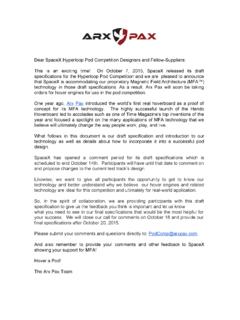Transcription of Hyperloop Extension - RRUKA
1 Hyperloop Extension (S260) Version: 1 February 2017 KNOWLEDGE ANALYSIS Hyperloop : concept, technologies and business model (S260) Copyright RAIL SAFETY AND STANDARDS BOARD LTD. 2017 ALL RIGHTS RESERVED This work comprises, in part, of a review of existing works published by others. The Rail Safety and Standards Board makes no claim on these works and copyright remains with the original owner. Any queries can be directed to This publication can be accessed by authorised audiences, via the SPARK website: Published: February 2017 All licensed for reuse under this Creative Commons Licence Scope of this knowledge search As a quick knowledge search, this report provides key bibliographical references and limited analysis.
2 It is intended to inform decisions about the scope and direction of possible research and innovation initiatives to be undertaken in this area. It does not provide definitive answers on this issue; and is not intended to represent RSSB s view on it. The search may only include what is available in the public domain. It has been conducted by a team with expertise in gathering, structuring, analysing both qualitative and quantitative information, not by specialists in the field. Experts in railway operations or other personnel in RSSB, or elsewhere, may not have been consulted due to the limited time available.
3 Industry and experts in this field are very welcome to make observations and to provide additional information. Please send comments to For further information or background to this report, please contact RSSB Knowledge Management and Systems at 3 | Executive Summary This knowledge search was undertaken on behalf of the RSSB Innovation team, to see what information is available in the public domain on the Hyperloop concept, technologies and business model. The Hyperloop concept was made popular by Elon Musk, CEO of spacex , in a 2013 communication.
4 In a white paper entitled Hyperloop Alpha , Elon Musk described the concept of a near supersonic, fixed-guideway, intercity transportation system which would disrupt passenger and freight transport in the near future. The idea stems from the pneumatic tube based vactrain concept (1909), and from other ideas and technologies developed by spacex . The Hyperloop was advertised as a system capable of shuttling passengers or cargoes between cities in much less time than a modern commercial aircraft (with a speed of 1200 km/h or 760 mph) due to the minimisation of friction and air resistance, using lower power consumption than traditional high speed rail, and being fully automated, collision free, and immune to weather.
5 spacex developed the first proof-of-concepts and launched public competitions for testing their designs, and commercial ventures have more recently started developing the needed technologies, like Hyperloop One, Hyperloop Transportation Technologies (HTT) and Transpod. Many governments (in India, Dubai, Russia, the People's Republic of China, South Korea, USA) have commanded feasibility studies on the Hyperloop , demonstrating their growing interest in the subject. San Francisco Los Angeles, Helsinki Stockholm, Dubai Abu Dhabi, Vienna Bratislava Budapest, and Toronto Montreal have been proposed as the first Hyperloop routes to be deployed.
6 This report aims at providing a high-level evaluation of the Hyperloop in terms of its technological advancement, commercial potential, costs, and remaining safety issues. The individual technologies on which the Hyperloop concept rely (partially evacuated tubes, passive maglev, linear induction motors, regenerative breaking) are to some extent already established technologies, or have been demonstrated to be successful in recent trials. However, this knowledge search found no evidence of these technologies having been successfully integrated on a wide scale system level.
7 As a result, the announced dates for the deployment of the first Hyperloop routes (2020) seem to be over optimistic. The main value proposition of Hyperloop (and its main disruptive characteristic) is to offer high speed transport at a cheaper cost than high speed rail and commercial airlines, due to lower investment costs (lighter infrastructure, less land usage and civil engineering work) and lower operational costs (full automation, lower power consumption, local energy production and storage). However, our research and analysis shows that the announced construction and operational costs are likely to have been underestimated by a factor of 2 to 3 at minimum.
8 For instance, whereas the initial Musk proposal for the San 4 | Francisco/Los Angeles route mentioned investment costs of $54 million for the pods and $650 million for the tube infrastructure, a more recent estimate published in the Ivey Business Review gives respective figures for the pods and the tubes in the range of $147 - 159 million and $1,650 - 2,480 million. It was also found that the maximum annual capacity of the Hyperloop is likely to be half that of High Speed Rail. Although it is 2-3 times more fuel efficient than rail, it offers less interoperability because of the partially vacuumed operating conditions.
9 Finally, there remain many unaddressed engineering and safety issues, that hinder the chances of a passenger Hyperloop system being ready for deployment in the next decade. For instance, it is unclear how the system will deal with heat dissipation in an ambient pressure around 1/1000 of the atmospheric one, with capsules running at 760mph. Thermal expansion of the tube, which could reach 300 meters on a 560km of route in California (with a temperature differential of 50 C), has likewise not been given a credible mitigation solution in the available Hyperloop proposal.
10 The business model of the Hyperloop relies on a very close proximity of the travelling capsules, which causes many safety concerns in case of system failure. The traveling pod has, at around 760 mph, a kinetic energy of just over 3 million joules, which is equivalent to the energy of 75 to 200 kilograms of exploding TNT (depending on the size of the pods and passenger numbers). With no way of dissipating that energy in the advent of an accident (in contrast to aircrafts), the Hyperloop cannot pass through residential or urban areas without becoming a great safety concern.







